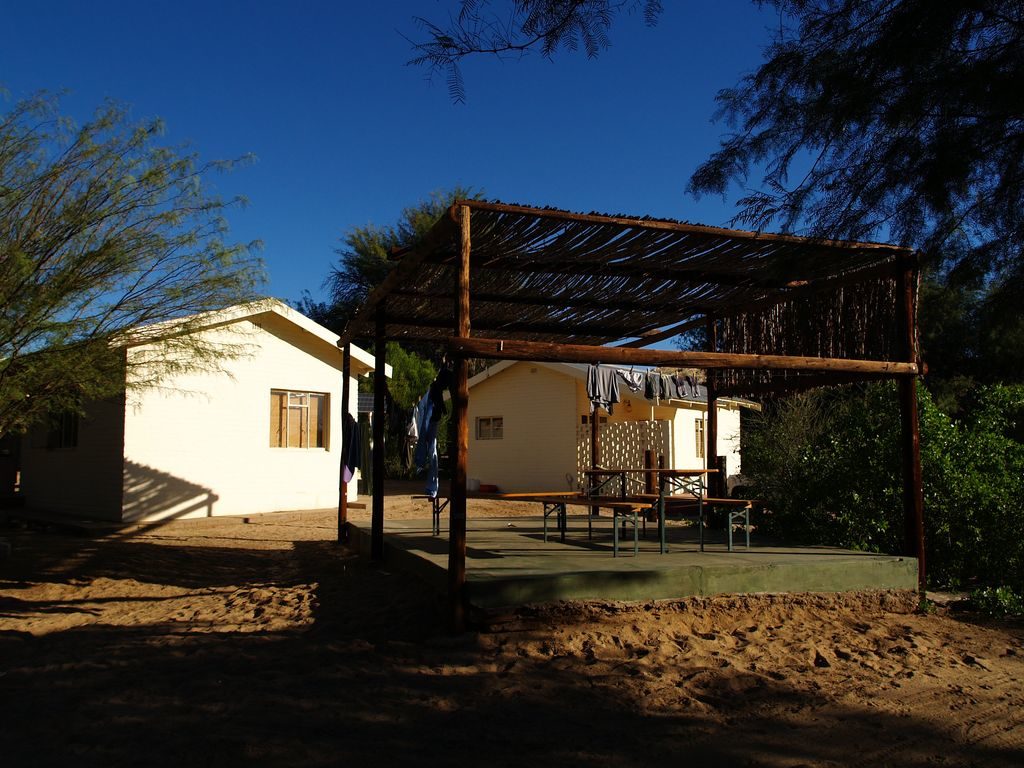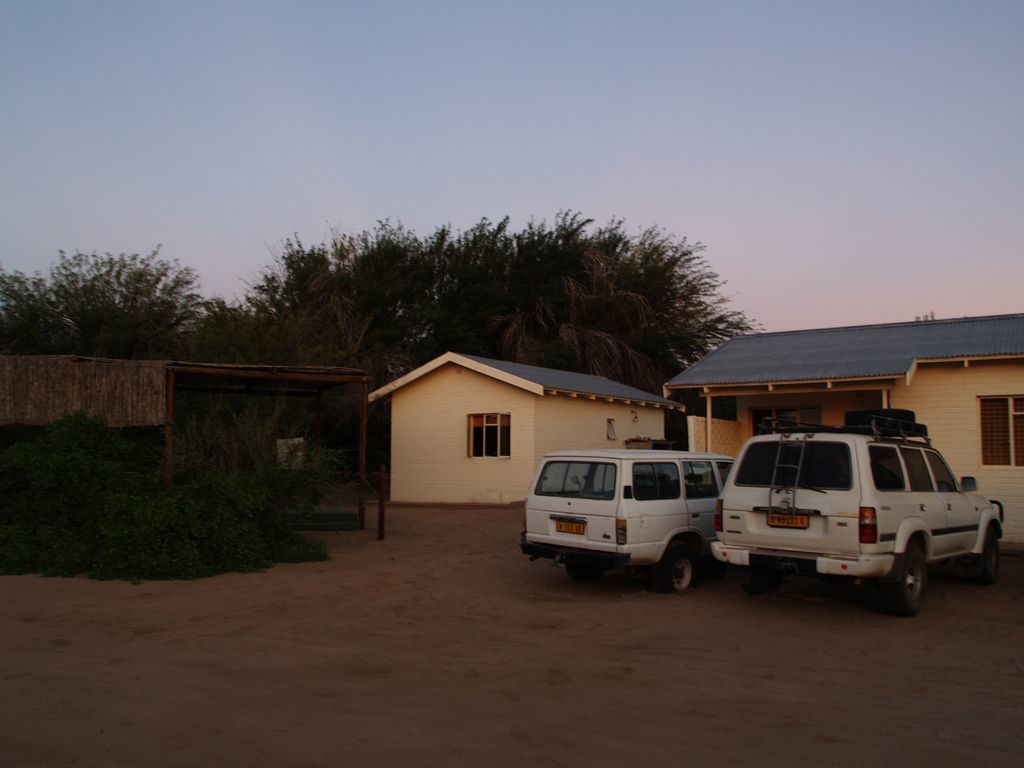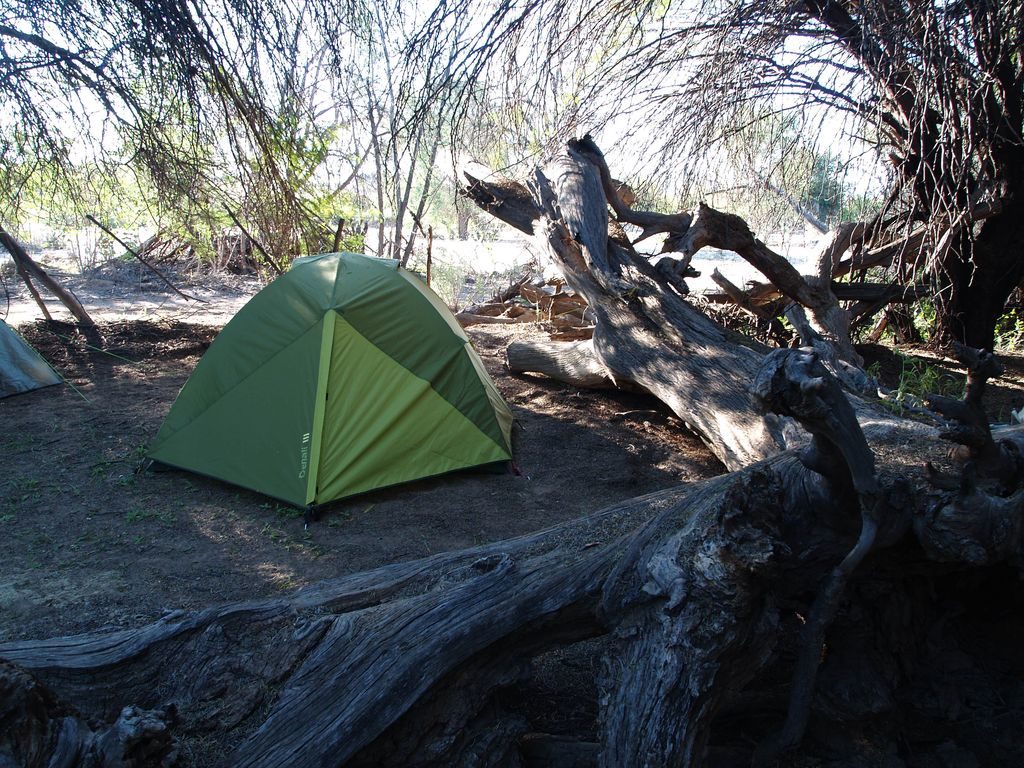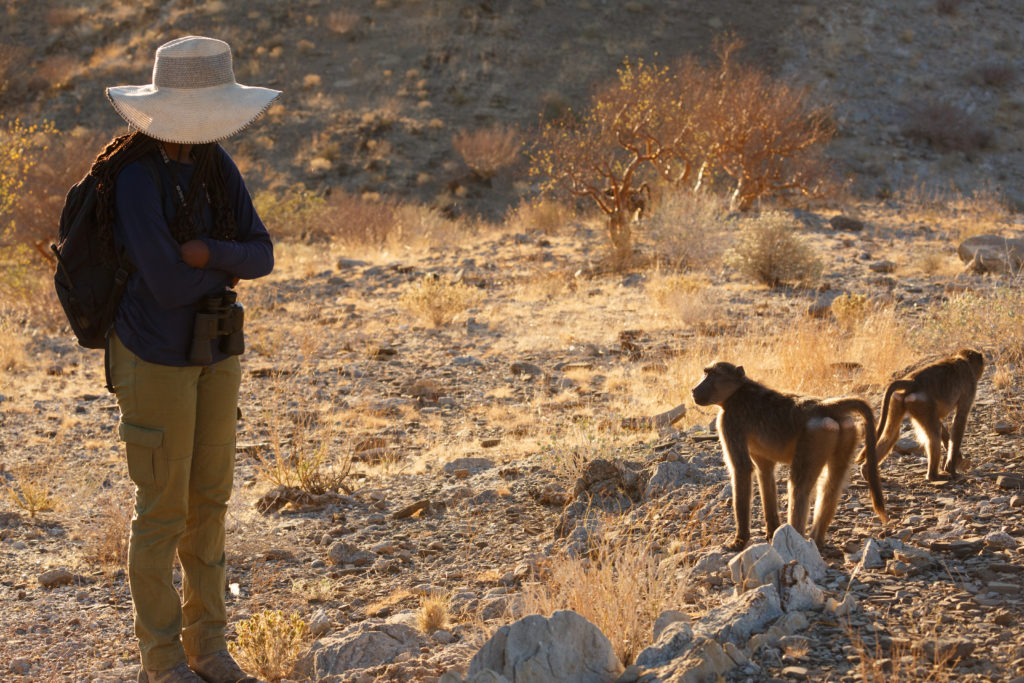
What we cover
The Tsaobis Baboon Project covers all our interns and field assistants’ work-related costs in Namibia, including all meals and accommodation. We also cover the costs of personal insurance, and:
- For our international volunteers, we further arrange and pay for the Namibian study visas
- For our Namibian interns, we further provide a monthly allowance of N$2,000 and the loan of field equipment as required
Who are we looking for?
These positions are open to all with an interest in animal behaviour and ecology. We are particularly keen to hear from applicants who:
- Are friendly, easy-going people, happy to live in small team under basic conditions at a remote field site
- Are strongly motivated, reliable and committed
- Have good levels of physical fitness and stamina – you will be following the baboons on foot from dawn to dusk over mountainous terrain in extreme heat
- Show good initiative, with a willingness to learn and show attention to detail
- Have a full, clean driving licence (international volunteers only)
How to apply
If you would like to apply, you will need to send a CV and covering letter, by clicking through to our recruitment page.
The covering letter should explain why you would like to work on the project, specify the internship positions to which you are applying, and confirm the earliest/latest dates of your availability. The CV should include the names of two referees with e-mail contact details.
* * * * * *
The Study Site

Weather
Tsaobis has a desert climate, with extreme heat and little rain. It is also very seasonal. Our fieldwork usually takes place over the dry austral winter, between May and October, so although the days are hot the nights are cool (temperatures can fall as low as 0oC in midwinter). From late winter, the days get noticeably longer and hotter, and sporadic thunderstorms become increasingly likely from October onwards.
Landscape
Tsaobis is a beautiful desert wilderness. The landscape is a mixture of alluvial and gravel plains, rocky hills, and nearby mountain peaks. Most vegetation comprises herbs, small shrubs, and dwarf trees, although the dry sandy bed of the ephemeral Swakop River that cuts through this landscape supports several woodland groves. Following summer rains, the desert springs into life and the baboons forage across the hills and plains. In the winter time, as the summer growth dies back, the baboons forage primarily in the Swakop River woodlands. Throughout the year, the baboons sleep on cliffs in the rocky hills.
Wildlife
Tsaobis is home to a variety of wildlife including mountain zebra, kudu, springbok, klipspringer and, of course, baboons! Predators include jackals and, occasionally, leopards. Birds and reptiles also abound.
Location
Tsaobis is centrally located in Namibia. It is only a 3.5 hour drive from Windhoek (the capital). The nearest town, Karibib, is a one-hour drive away and comprises a petrol station, bank, post office, and basic shops.
Working Conditions
Daily Schedule
Data collection requires full-day follows of the study troops. This ensures that the location of the sleeping cliff used by the baboons each night is known, which in turn facilitates their pick-up by observers early the next morning. If the day begins late, or ends early, the baboons can be lost and may take several days to relocate. Full-day follows require that the field team have already had breakfast, prepared their pack lunches, and are ready to leave camp in good time before dawn; it also means that they will not get back before nightfall. The most distant baboon sleeping cliffs are more than an hour away from camp, so a prompt start in the morning is essential (e.g. 4:30am). The baboons are then accompanied until they reach their sleeping cliff at dusk (e.g. 6pm, returning back to camp by 7pm). Although these are long days, the weekly schedule ensures that there are regular breaks for all the team (see below).
Working with baboons in the Tsaobis landscape
Observers spend the day on foot in the company of the baboons as they traverse the rocky, mountainous terrain around the Swakop riverbed. This landscape is beautiful but also physically demanding. Field team members travel (with backpacks) up to 10km a day, ascending and descending steep hills and slippery scree slopes as they follow the baboons. The baboons are habituated to the presence of human observers, allowing data to be collected from close proximity without causing disturbance, but observers must always act carefully and responsibly when in the company of these wild animals. Data collection is largely conducted with handheld computers. Faecal and urine samples may also be collected on a routine basis. On-site supervision and detailed guidelines will be provided describing how to work with the baboons in this desert landscape.
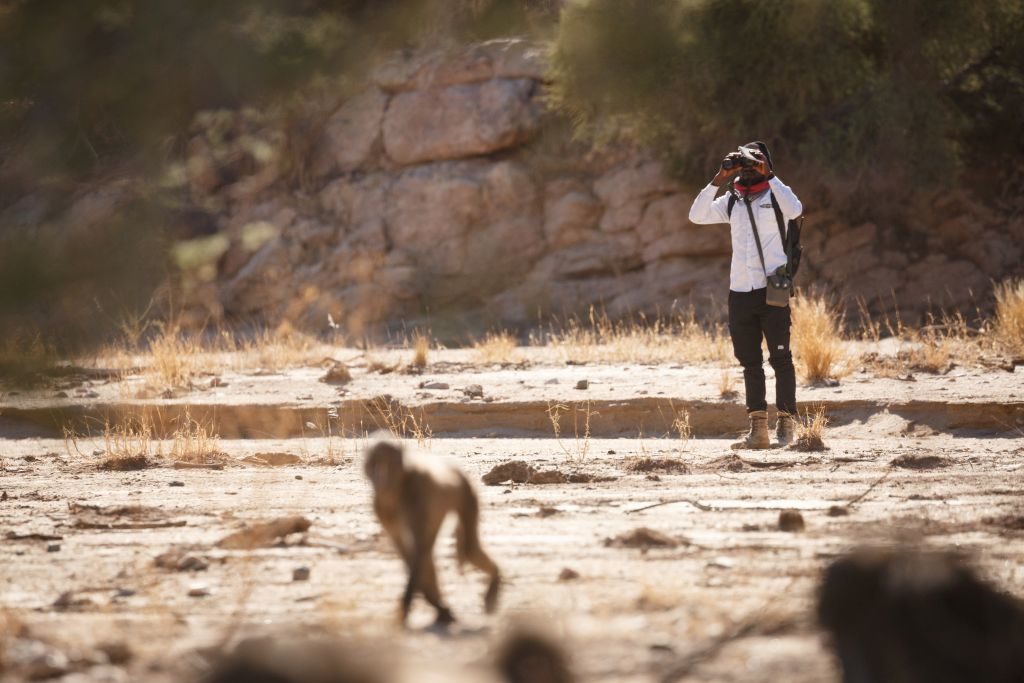
Credit: G Duvot 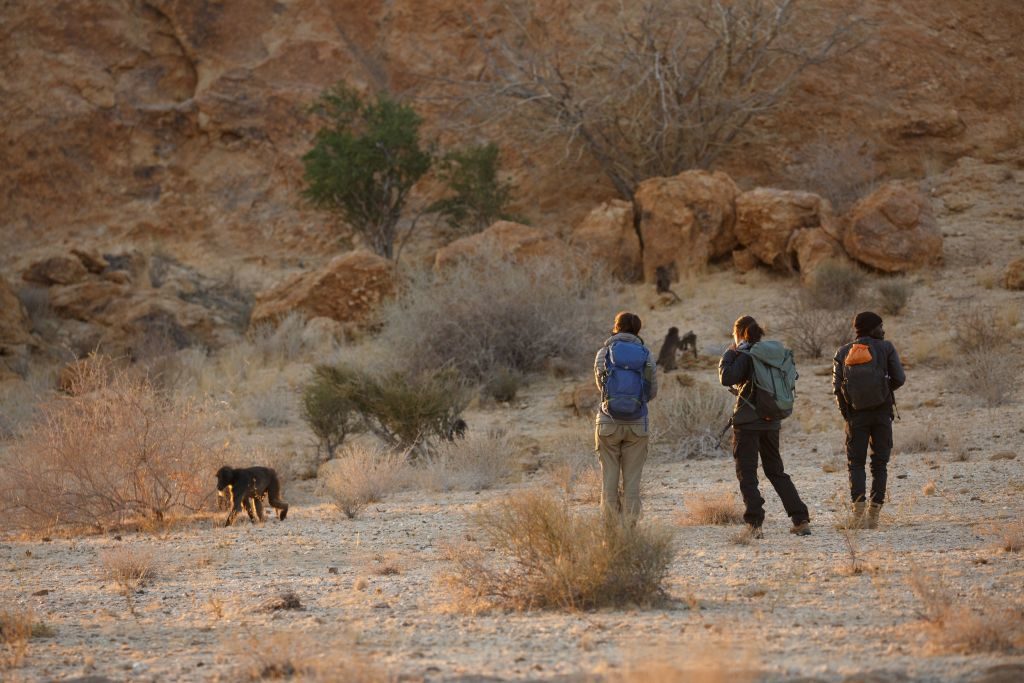
Credit: G Duvot
Environmental surveys and monitoring
At monthly intervals throughout the field season, plant phenology surveys will be conducted. These are an important complement to the baboon behavioural data, since they describe the spatial and temporal availability of the baboons’ food patches.
Weekly work schedule
Since data collection from the baboons requires consecutive full-day follows, these “field days” usually take place over two-day stints with an intervening one-day break. The latter are primarily “rest” days, but there will also be some office and general housekeeping duties (e.g. uploading data to the project databases, cooking supper). Trips will be made to Windhoek about once a month for supplies, and volunteers will also be expected to assist occasionally with these trips. Although the field-office/rest day cycle of 2-1 days is the normal routine, this schedule necessarily retains flexibility throughout the field season.
Living Conditions
Accommodation
Accommodation is based around a small two-roomed bungalow. The bungalow has a kitchen, bathroom and office. Members of the field team sleep in their own tents which are pitched under trees close to the bungalow, but use the living area of the bungalow for rest and relaxation.
Food
Field team members prepare their own breakfasts and pack lunches, but for supper we cook communally, with all team members taking turns to prepare the evening meal. Due to limited refrigeration/freezer space, communal food is vegetarian.
Telephone and messaging
Tsaobis has no mobile phone coverage, but the Project has access to the rest camp telephone and wi-fi which usually has a sufficient signal for WhatsApp (without pictures).The project covers the costs of the wi-fi service, but volunteers will need to pay for any phone calls they make at local rates.
Visitors
Members of the field team may receive visitors at Tsaobis, but volunteers should consult the Project prior to making arrangements as permission from relevant landowners needs to be sought. Care must be taken that visitors do not disrupt the field routine and all plans and arrangements for visitors must be confirmed with the Project Director prior to the visit. Unfortunately, accommodation for visitors cannot be guaranteed at the field site and it will not be possible for visitors to accompany the volunteers when working with the baboons.
Personal Details
Preparation
In addition to organising equipment (see below), there will be various tasks and pieces of paperwork that volunteers must complete before they can travel to Tsaobis. Work on two key tasks should be initiated as soon as the volunteer has been firmly accepted onto the Project, namely the arrangement of:
- flights, and
- vaccinations (see below)
We will organise the visa paperwork and travel insurance for the volunteer. In addition, where possible, we encourage volunteers to do a little background reading on baboons before coming to Tsaobis. In particular, Louise Barrett’s “Baboons: Survivors of the African Continent” (BBC, 2000) is an excellent introduction to the world of baboons, while Robert Sapolsky’s “A Primate Memoir” (Vintage, 2002) is a wonderful account of fieldwork with baboons.
Health and safety, general
All volunteers must be aware of their blood group and will need to ensure that they are up-to-date with their vaccinations. For the most recent information and treatment, volunteers are recommended to visit their local travel clinic or GP. This should be done as soon as the volunteer has been accepted onto the Project, since some vaccination courses can require several months between the first and last injection. Because the volunteers will be working with wild primates, vaccinations for hepatitis B and rabies must be obtained in addition to the standard vaccinations for Namibia. There is no malaria in this region of the country, but if volunteers plan to travel further north before or after the field season, e.g. to Etosha National Park, anti-malarials will be required.
Health and safety at Tsaobis
Because fieldwork at Tsaobis is conducted on foot and takes place from dawn to dusk, often over difficult terrain, volunteers should be physically fit. Due to the dry desert climate, Tsaobis is a healthy place to work, but volunteers will need to take appropriate steps to avoid dehydration, sunstroke and excessive sun exposure. This includes carrying plenty of water, wearing wide-brimmed hats with appropriate clothing and sunglasses, and the regular application of sunblock.
Health and safety outside Tsaobis
Although the tar and gravel roads in Namibia are generally excellent, all volunteers should drive carefully and at reasonable speed, and never drive at night. Although Namibia is generally a safe country to visit, when in Windhoek (and other urban areas) it is a sensible precaution to stay alert and avoid walking the streets at night, especially alone. For further details on health and safety in Namibia, please refer to the UK Government’s travel advice.
What to Bring
Clothes
Due to the cold nights and hot days of the desert winter, field team members should bring sweatshirts and jumpers as well as light summer clothes. Woolly hat, gloves, and a warm fleece are essential for cold winter mornings and evenings. Field clothes should include long-sleeved shirts and long trousers, in addition to t-shirts and shorts. Avoid wearing dark colours if possible; lighter colours are much cooler. A wide-brimmed hat and sunglasses are essential. A small lightweight waterproof windcheater is also indispensable for windy winter mornings. In addition to field clothes, some smart clothes will also be useful (e.g. for visits to Windhoek). Footwear should include a robust pair of walking boots and a sturdy pair of sandals.
Equipment
Personal equipment should include:
- A tent. Ideally your tent should be three person, since it will also double as your private retreat. A mattress will be available, but your tent will need to be large enough to accommodate it. The mattress dimensions are 190cm x 88cm x 15cm.
- A 3-season sleeping bag
- A comfortable backpack for daily use in the field. Ideally bring a backpack with a waist strap as well as shoulder straps, so that the weight of the bag can be carried on the hips rather than the back. Backpacks that are moulded to allow air to pass between the bag and your back (e.g. the Berghaus “freeflow” design) are cool to wear. Backpacks should be a minimum of 25-30 litres volume.
- A comfortable pair of hiking boots. Ideally these should be lightweight but robust (with ankle support).
- A good set of binoculars, ideally 8×40 or 10×40. Avoid poor binoculars: they will make your work difficult and frustrating.
- A spare pair of spectacles (if used)
- A torch (ideally a head torch)
- Ankle-length gaiters
- A simple compass and whistle
- A sewing kit
- A water bottle can also be helpful, although most of the time we simply re-use the bottles that come with bottled water and soft drinks.
- Many previous volunteers have found it useful to bring a laptop, camera, MP3 player, e-reader, and/or books to read. A weather-proof bag, or just a ziplock bag, can be useful to keep valuable electronic equipment safe from dust and sand. Compact/travel games are always welcome, as are DVDs.
- Field guides can usually be purchased in Windhoek (mammals, birds, trees, herps, etc), and some are also available for reference at Tsaobis.
For personal expenses, volunteers can bring cash, and should also be able to make withdrawals from ATMs using a standard debit card. Credit cards are widely accepted and are recommended for emergencies.

